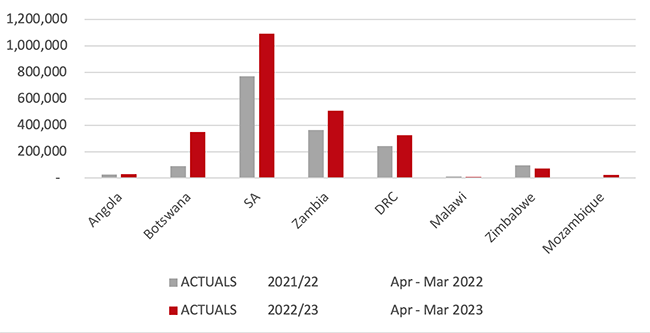Staff Reporter
The Walvis Bay Corridor Group (WBCG) has announced a sterling performance for the 2022/23 financial year, specifically in reference to substantially increasing corridor volumes. Corridor cargo volumes entering and leaving the
hinterland increased by 50% year-on-year, climbing from 1 639 510 tonnes to 2 464 123 tonnes.
This is the volume throughput recorded for the ports of Walvis Bay and Lüderitz, going to and coming from the target markets of Angola, Botswana, the Democratic Republic of the Congo (DRC), Malawi, South Africa, Zambia as well as Zimbabwe.
Prior to Namibia’s independence, there were absolutely no corridor volumes. The first cross border cargo was only initially recorded in 2004. The best performance was shown by the Botswana market with the growth of 285%. This was mainly due to new commodities introduced such as sugar imports from Brazil, coal and copper concentrate exports.
The South African market grew with 42%, from 771 852 tonnes to 1 093 569 tonnes. This market is mainly driven by manganese export from the Hotazel area near Upington in the Northern Cape through the port of Lüderitz.
In addition, DRC and Zambian markets have grown exponentially with 33% and 40%, respectively from 243 029 tonnes to 324 151 tonnes and 363 621 tonnes to 510 323 tonnes for both markets.
The CEO of WBCG, Mbahupu Hippy Tjivikua said; “The significant growth of corridor volumes is testimony that our business development initiatives and trade facilitation efforts are making an impact in the target markets. This is a result of team efforts between ourselves, Namport and all the relevant stakeholders along the supply chain. Moreover, the clients in these markets are increasingly finding our trade routes very efficient and safer.”
“Although a few challenges remain, great inroads have been made over the years, and this is all thanks to all our stakeholders’ support, input and commitment,” said Tjivikua.
The WBCG was established in 2000 to engage in business development activities, aimed at increasing cargo for the Namibian ports and Walvis Bay Corridors, as well as to facilitate corridor and infrastructure development. In addition, the WBCG was mandated by Namibia (through the National Planning Commission) as the implementing agency for realising the country’s vision of becoming a logistics hub for the Southern African Development Community (SADC).
The Walvis Bay Corridors are an integrated system of well-maintained tarred roads and rail networks, accommodating all modes of transport, from the Port of Walvis Bay via the Trans Kalahari Corridor, Walvis Bay-Ndola-Lubumbashi Development Corridor (previously known as the Trans-Caprivi), Trans-Cunene Corridor, as well as from the Port of Lüderitz via the Trans-Oranje Corridor providing landlocked SADC countries access to transatlantic markets.
Through its regional and global footprint, the Walvis Bay Corridors are well positioned to engage cargo owners, shipping lines, and supply chain decision-makers, to divert cargo from other trade routes to the Walvis Bay Corridors. The WBCG headquartered in Windhoek, Namibia, currently has offices in Johannesburg- South Africa, Lusaka- Zambia, Lubumbashi – DRC and São Paolo – Brazil.


